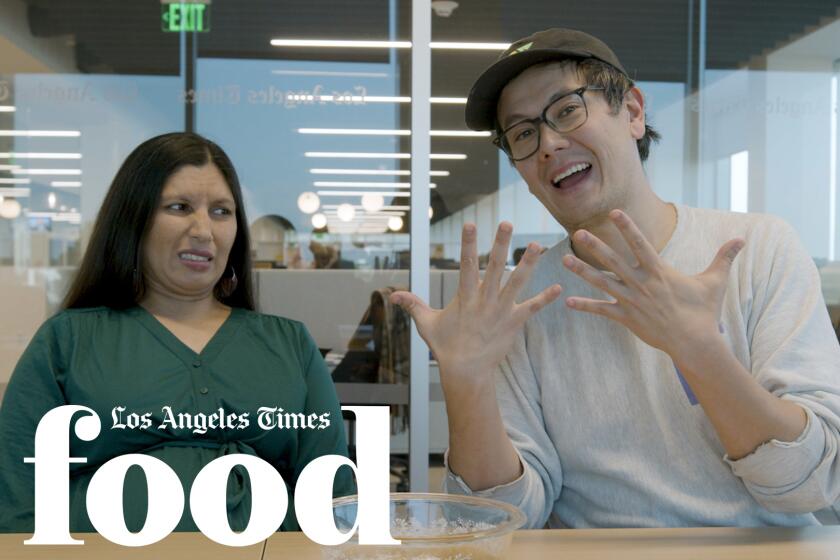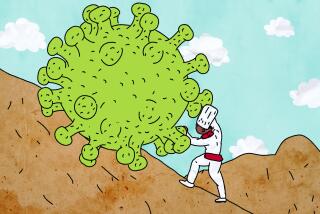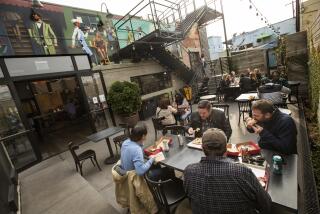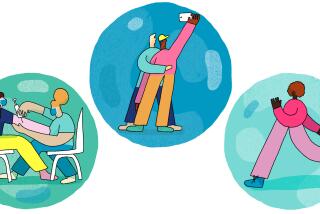Column: Eating in the time of coronavirus
- Share via
When I wrote this, barely a week ago, I consulted experts and smart people on how to think about eating out when coronavirus was a looming spectre on the horizon.
My, how things have changed. While all the advice below is good in almost any season, the stakes are different. We have not yet reached a point of mandated social distancing — though I wouldn’t be surprised if that arrived very soon — but it seems that most thinking about the best way to slow the spread of novel coronavirus and drive down the number of COVID-19 infections is to actively avoid unessential gathering outside of the home.
That means no dining out at restaurants, no dinner parties, no play dates for the kids. It means hunkering down as to not overwhelm our medical system and to make sure as many of us come through this together and intact.
Some restaurants are switching over to delivery and pick-up options; we can still opt in to those options for now and those businesses need support. (Kismet, Josef Centeno’s restaurants, and Bon Temps have all made me want to click and buy today.)
P.S. (Delivered in ornery old man voice) If you’re young and asymptomatic and love brunch and don’t get what all the fuss is about, you’re part of the problem! Stay home! Learn to cook!
___
A few days ago, my boss sent a Slack message to the Food team. Another editor at the paper, she said, “has an interesting idea: Should Food do something on if shared plates dining is being affected by the [corona]virus?”
“The reason I bring it up,” the editor explained, “is I got this invite to a communal dinner event that is ‘silverware optional.’ Seems like a bad idea.”
Cue some heated all-channel chiming in. (“I was thinking about that too when I went to a buffet this weekend, like is that sketch now??”) (“I’m the germaphobe of the group. Haven’t eaten at a buffet in years and never will again. Bring my own hand wipes everywhere I go.”) (“My dad was a doctor and wouldn’t even let us eat leftover M&Ms from his poker game because his friends put their dirty hands on them.”) (“Team lunch to sizzler.”)
I, being cranky and old, tried to throw water/gasoline on the fire by ranting about “Americans and their don’t-double-dip-in-the-salsa hand-sanitizer ways of eating” and proposing, facetiously, “Let’s ask for forks and knives at the Ethiopian restaurants!!”
Which is how we arrive here: What exactly should we think when it comes to questions of eating and the novel coronavirus panic and pandemic?
The problem: Most food writers are neither public health officials nor experts in any myriad forms of expertise than can be credibly leaned on to answer such a question.
After threatening to lick the armrests on my upcoming flight to Los Angeles (which I had to, spoiler alert, cancel because of a temporary ban on nonessential business travel by my employer), I did what any American does when they want more information on a subject: I turned to cable news.
Specifically, the coronavirus episode on “Last Week Tonight with John Oliver.” We’ll come back to what I learned from Mr. Oliver in a minute.
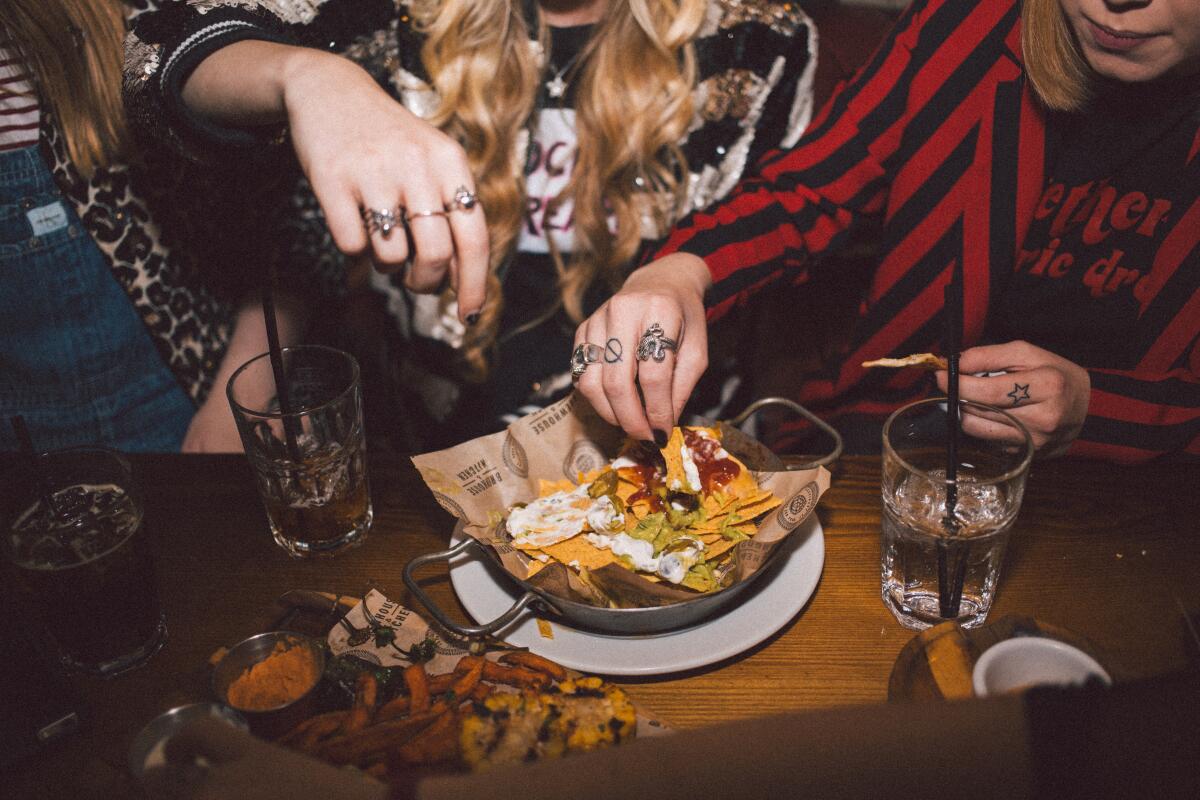
I think, first, it’s worth my saying that I came to this topic with the belief — informed by almost every public notice I’ve seen from the CDC and others — that there is little beyond the reasonable, everyday things we do during flu season to keep ourselves from getting sick.
Wash your hands. Stay home if you’re sick. If you’re immunocompromised, you already take extra steps to take care of yourself and should continue to do so.
Here are eight tips for cooking clean in your own kitchen to prevent germs from spreading and to make the cooking process more pleasurable.
Some estimates say that 70% of the American populace will catch the novel coronavirus and, for most, it will be like having a bad cold — not even a bad flu.
But still! We’re hoarding water! We’re hoarding oat milk! Chinatowns are empty! What should we do?
So I asked some experts.
First up: Marion Nestle, whom you could describe as the Paulette Goddard Professor of Nutrition, Food Studies and Public Health, Emerita, at New York University, or, if you’re me, say she’s the 800-pound-gorilla of “what she says goes and is generally grounded in heavy-duty academic truth when it comes to most issues of food policy and politics.” Either way.
So I put the questions above to her and she said:
“Silverware optional? These better be people you are happy to share germs with. Coronavirus, horrible as it is, doesn’t change dinner table courtesy and safety. Wash your hands before eating, use clean silverware, don’t eat off of common serving pieces or use your silverware to take food from common bowls or plates, and keep your hands out of food that other people might be eating. At an Ethiopian restaurant, use the injera to take food. Coronavirus is not spread by food or water; it’s spread by coughing, sneezing and unwashed hands. Share food? Of course but sensibly.”
Doesn’t that make so much sense? Be clean and considerate and respectful of the people around you! It is less fun than kneecapping somebody who is about to buy all of the packages of instant ramen you want to stockpile, but it is actually what we know works.
Does this mean eating out is 100% safe? No! I hate to break it to you this late in life, but nothing is!
What happens when you try to make your hand sanitizer with stuff you got from BevMo to ward off the coronavirus? Just wash your hands instead.
I turned to my colleague Emily Baumgaertner, who reported on the Ebola and Yellow Fever outbreaks in Africa from Africa and has a master’s in public health from George Washington University. She summed up the situation as such:
“You’ve donned a completely unnecessary mask, commuted across town to the restaurant, and, safely inside, scrubbed your hands for two Happy-Birthday [songs] in the restroom. That’s great. But virologists have figured out that viruses found [in] respiratory droplets can survive on inanimate surfaces for hours. They’re on business cards, elevator buttons, door handles — and, yes, tables.
Don’t get me wrong: I’m happy for you someone didn’t sneeze directly into your mouth — or even into your plate of food. But if someone sneezed onto the table that you’re now touching with your uber-sterile hand, and you unknowingly reach up and touch your face, you’re out of luck. So please: go. Enjoy meals with your friends. But consider wiping down surfaces often, at least until the COVID-19 spread subsides.”
I believe that restaurants, for themselves, not for us, keep as clean as possible as often as possible, but truth is truth, and that’s Emily’s take on the specific risks.
I texted with Arielle Johnson about the issues at play too. You may know her from such L.A. Times Food stories as “How to eat a tree” or as one of one of Glamour’s Women of the Year, but I’ll offer you how she described herself in our texts: “I am not an expert, I am just a food chemist who reads enough to be a dilettante.”
And after running through the should-I-still-eat-around-other-humans non-conundrum (she had a similar take to Nestle’s), we segued to chatting about the reported supermarket hysteria going on.
“Some people are stockpiling months of food and, like, friend, if society has broken down so much that there is no food for a month, we have much bigger problems than making our personal stash last. Humans are social animals. They’re not supposed to be doing the food-getting by themselves, ever.”
Johnson invoking our togetherness brought up two other coronavirus-adjacent topics: The general insecurity of minimum wage and other food service workers in the current American capitalist paradigm and the particular restaurants that people are avoiding.
The first is a broad and deep topic. My colleague Julia Wick, writer of the Essential California Newsletter, summed up the situation well in messages we traded:
“We live in a deeply broken country where many hourly service workers lack the economic power to just ‘take the day off,’ and we have no federally mandated paid sick time ... and even if we did, job repercussions could still be an issue for a lot of people.” Jaya Saxena wrote more on the topic over at Eater.
Here’s the thing: Food service workers, regardless if they work at the cheap buffet or the fancy restaurant, don’t want to get sick either. If you can’t trust that they’re doing their best to keep themselves — and, by extension, you — safe, then your problems are deeper-seated than a Food section can help you with.
But those problems might brush up against John Oliver’s first rule for not getting novel coronavirus: “Don’t be racist.”
As he put it, “That’s just good advice for now — and for later.”
So don’t avoid Chinatowns. Don’t avoid the turo turos that Garrett Snyder wrote up for this section, or the SGV restaurants that our critics have recently spotlighted. Don’t think that the color of the skin of the people in a restaurant has a thing to do with whether it’s where you’re going to catch coronavirus. It doesn’t.
“But but but” — I hear the hamster wheels in some of your brains spinning — “what if the people at the restaurant are from Wuhan? Doesn’t that make a steakhouse [or substitute any restaurant you assume has no Wuhanese employees] safer than a Chinese restaurant [again, acknowledging that over a billion people live in China and most of them have probably never been to Wuhan]?”
Though I am tempted to roll up my (print) newspaper and batter you about the ears like a 1950s dad in a suburban sitcom, I instead hit up Baumgaertner again.
We went back and forth and discussed how maybe — very maybe — right after news of novel coronavirus broke, if you knew that an employee of a restaurant had been in Wuhan within the previous 14 days and had been within 6 feet of an infected person, maybe the risk at that restaurant was higher. (Of course it is Hogwarts-level fantasy to think you could know that much about every member of a restaurant’s staff.)
But, she conceded, “Now that we’re seeing signs of community spread, it REALLY makes no difference whether you go to a Chinese restaurant or a steakhouse.”
So do what your mom probably told you to do years ago: Wash your hands, don’t cough in the food, and be reasonable in your response — don’t expend energy on things you can’t control.
Also, please spin the Lazy Susan over my way so I can get some of those noodles.
More to Read
Eat your way across L.A.
Get our weekly Tasting Notes newsletter for reviews, news and more.
You may occasionally receive promotional content from the Los Angeles Times.
